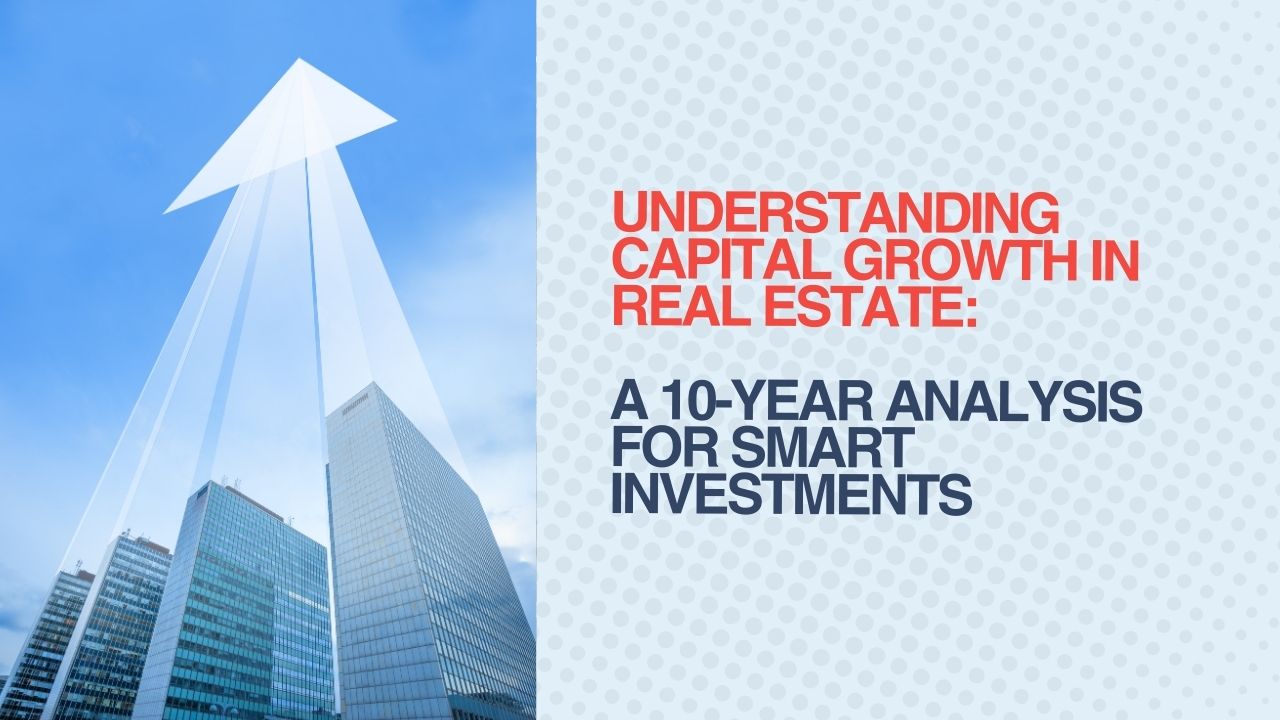Understanding Capital Growth in Real Estate: A 10-Year Analysis for Smart Investments
- October 29, 2024

When it comes to property investments, one of the most critical metrics to consider is capital growth. This term refers to the increase in the value of an asset over time, and in the context of real estate, it can significantly impact your investment decisions. By understanding capital growth over a sufficient time frame, such as 10 years, investors can better assess the potential of a property or area for future growth. In this article, we’ll explore the significance of analysing capital growth over a decade, the key factors influencing this growth, and how investors can use this metric to make informed decisions.
What is Capital Growth?
Capital growth is the increase in the market value of a property over time. Unlike rental income, which provides regular cash flow, capital growth is realized when you sell the property at a higher price than you initially paid. It is essential to understand that capital growth is influenced by several factors, including supply and demand dynamics, employment trends, population growth, and economic stability.
Analysing the capital growth of a property over a longer time frame, such as 10 years, allows investors to observe how the property market has evolved through different economic cycles. This data provides insights into the overall stability and resilience of a property or area, helping investors assess whether it aligns with their long-term financial goals.
The Importance of a 10-Year Time Frame
A 10-year time frame provides a robust dataset that captures the movement of property prices over an entire property cycle. Unlike short-term fluctuations, which can be influenced by temporary market factors, a decade-long analysis reveals the underlying trends and market fundamentals that drive property value growth. This allows investors to make decisions based on historical data rather than reacting to short-term market changes.
For example, consider two contrasting areas: Brighton in Victoria and Blackwater in Queensland. Over the past decade, Brighton has experienced a capital growth of 254%, while Blackwater has seen a decline of 52%. By analysing the data over this extended period, we can better understand the fundamental factors contributing to these divergent trends.
Key Factors Influencing Capital Growth
- Demographics and Education Levels: Demographics play a significant role in determining the capital growth potential of an area. Areas with higher levels of tertiary education often attract professionals and a more affluent demographic, which can contribute to the area’s desirability and, subsequently, property values. For example, Brighton, with a higher percentage of tertiary-educated individuals, tends to have more diverse employment opportunities across various industries, contributing to its sustained growth.
- Employment Trends and Industry Diversity: Areas with diverse employment opportunities tend to be more resilient to economic downturns. Blackwater, for example, is heavily dependent on the mining industry, making it susceptible to market downturns when demand for mining output decreases. In contrast, Brighton has a more diversified employment base, which provides stability and reduces the risk of significant price drops. Analysing industry diversity and employment trends can give investors a clearer picture of the area’s economic health and long-term growth potential.
- Supply and Demand Dynamics: The balance between housing supply and demand is a crucial factor in capital growth. If an area has a limited housing supply but high demand due to factors like a growing population or proximity to job hubs, property values are likely to rise. Investors should look at historical supply and demand trends in the area over the past decade to determine whether there is potential for future growth.
How to Use Capital Growth Data in Investment Decisions
While capital growth is a powerful metric, it’s important to remember that it should not be the sole factor driving investment decisions. Instead, it should be used in conjunction with other key metrics, such as rental yield, vacancy rates, and market fundamentals. Here’s how investors can use capital growth data effectively:
- Compare Areas for Investment: By comparing the 10-year capital growth of different suburbs, investors can quickly identify which areas have shown consistent growth and which ones have stagnated or declined. This helps in narrowing down potential investment locations.
- Assess Market Fundamentals: Once an area with strong past capital growth is identified, investors should further analyse market fundamentals like employment, demographics, and industry diversity to ensure the area is positioned for continued growth.
- Avoiding Risky Investments: On the flip side, analysing capital growth data can help investors avoid areas with high risks. For example, Blackwater’s 52% decline in value over the past decade highlights its vulnerability to economic changes in a single industry.
Track Your Property Portfolio with Property Dollar
Investing in real estate requires careful analysis and ongoing monitoring of your portfolio’s performance. With Property Dollar, you can track your property portfolio’s growth in real time, allowing you to make data-driven decisions. Property Dollar provides valuable insights into your portfolio’s equity, repayment schedules, and overall performance, helping you stay ahead of market trends.
By leveraging capital growth data and using tools like Property Dollar, investors can better position themselves for long-term success in the property market. Understanding the past trends and market fundamentals of an area can be the key to building a robust and profitable property portfolio.
Disclaimer: The information provided in this blog is general in nature and not intended to be personalized financial advice. Please consult a financial advisor before making any decisions regarding your finances.




